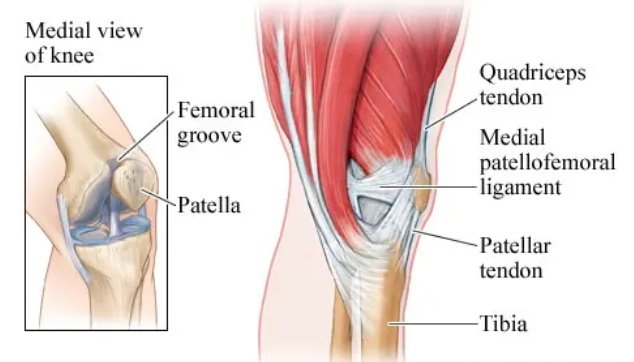Physical Therapy for Medial Patellofemoral Ligament Injury
Medial patellofemoral ligament (MPFL) injury involves a strain or tearing of the MPFL, typically due to a traumatic kneecap dislocation. The MPFL is a ligament located on the inside of the knee joint, connecting the kneecap and thighbone and providing stability to the kneecap. Physical therapy helps those with MPFL injuries restore knee strength and function and provides post-surgery rehabilitation if surgery is necessary.
What is the Medial Patellofemoral Ligament (MPFL)?
The medial patellofemoral ligament, or MPFL, is a ligament located on the inside of the knee joint and connects the kneecap (patella) to the thighbone (femur). The primary function of the MPFL is to provide stability to the kneecap and keep the kneecap centered such that it glides properly during leg movement.
The MPFL restrains any movement toward the outside of the knee and helps to keep the kneecap in position as the knee bends and straightens. Without the MPFL, the kneecap dislocates laterally (sideways, away from the other knee).
What does MPFL injury involve?
A medial patellofemoral ligament injury involves a strain or tearing of the MPFL, typically due to a traumatic kneecap dislocation. It is more common among young, active females and in athletes who play football, racquetball, tennis, and basketball, sports that require significant pivoting. If an individual has naturally loose ligaments, most frequently seen in girls and women due to hormonal changes, they can be more at risk of tearing the MPFL.
When the kneecap dislocates, soft tissues including the MPFL are damaged as the patella jumps the groove and then comes forcibly back into place. The kneecap dislocates outward, causing the MPFL on the inside of the knee to stretch and tear. This is generally an acute injury from which the individual will experience acute pain and immediate swelling.
If the acute tear of the MPFL is left untreated, chronic MPFL insufficiency can develop in which the MPFL does not function properly and leads to repeated patellar dislocations, pain, and stiffness in the knee. This is because the MPFL, when left to heal on its own, heals in a loosened, lengthened position.
Common symptoms of an MPFL injury or tear include:
Feeling that the knee gives way or buckles during activity
Feeling that the kneecap is sliding out to the side during knee movement
Swelling of the knee after activity
Restricted knee range of motion
Pain when moving the knee
Tenderness to touch along the knee joint
Knee stiffness and locking after sitting with the knee bent or straight for a long time
Physical Therapy Treatment for MPFL Injury
Physical therapy helps those with MPFL injuries restore knee strength and function and provides post-surgery rehabilitation if surgery is necessary. Conservative treatment for MPFL including physical therapy is generally attempted first to strengthen the dynamic stabilizing muscles of the knee. During the initial physical therapy evaluation, the physical therapist assesses knee range of motion, strength, and flexibility as well as kneecap mobility compared to the uninjured knee.
Physical therapy treatment for MPFL can include:
Range of motion exercise to restore knee joint movement
Muscle strengthening of the muscles around the knee joint, particularly the quadriceps and hamstrings, to help manage the force applied to the knee. Core and hip strengthening helps balance the amount of force on the leg and knee and maintain proper alignment.
Manual therapy: hands-on soft tissue and joint mobilization to restore joint movement, flexibility, and strength.
Pain management using ice and heat
Use of compression sleeves to reduce pain and swelling. Bracing the knee can provide extra support through special padding around the kneecap.
Functional training and return to sport protocol for a progressive return to sport.
If the MPFL is severely injured or the patient has had previous kneecap dislocations, surgery may be necessary to restore and reconstruct the injured ligament and stabilize the knee. Physical therapy is essential after MPFL surgery to regain full function in the knee.
Post-surgical physical therapy involves four phases of rehabilitation:
Protective phase (Day 1-Week 6): During this phase, the goal is to protect the surgical site, reduce swelling, restore passive knee range of motion, and begin gentle strengthening of the calf raises, quadriceps, and hamstring.
Moderate protection phase (Weeks 7-12): During the moderate protection phase, the physical therapist works to maintain full range of motion, safely progress strengthening, and promote proper movement patterns. Strengthening may include squats, lunges, proprioception drills, balance training, dynamic stabilization drills, and neuromuscular control training.
Minimum protection phase (Weeks 13-16): During this phase, the goal is to gradually return to functional activities. To allow a gradual return to functional and athletic activities, the involved knee must have loads gradually applied up to that of the level needed to perform higher functional activities such as running and jumping. To do so, the physical therapist progresses strengthening using weights, introduces plyometric and agility training, and initiates return to running and sport training.
Return to sport phase (Weeks 17-20+): The physical therapist progresses to full functional training and return to sport training, continuing strengthening and proprioceptive drills and sport-specific drills.

